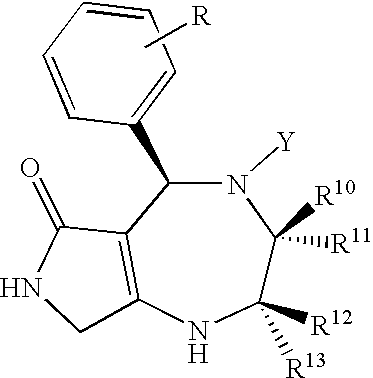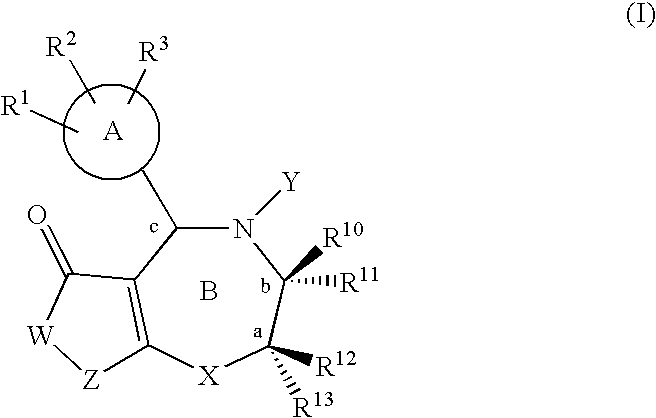Fused polycyclic compounds
a polycyclic compound and fused polymer technology, applied in the field of new fused polymer compounds and drugs, can solve the problems of inability to obtain insulin action to improve hyperglycemia, complication of procedures, and need for patient education, and achieve the effect of low side effects and high medicinal properties
- Summary
- Abstract
- Description
- Claims
- Application Information
AI Technical Summary
Benefits of technology
Problems solved by technology
Method used
Image
Examples
example 1
[0069]
[0070] 464 mg (5.27 mmol) of (R,R)-2,3-diaminobutan (IIIa) and 1.23 g (5.27 mmol) of a compound (IVa) synthesized by the method described in a literature (Tetrahedron Asynmetry 1996, 7(8), 2365-2370) were fused and purified in accordance with the method described in WO02 / 44180 to obtain 1.00 g of a Process 1 compound (Va) (yield 63%) as a pale yellow solid substance.
[0071]1H-NMR(300 MHz, CDCl3) δ=1.07(3H, d, J=6.3 Hz), 1.14(3H, d, J=6.6 Hz), 2.97-3.17(2H, m), 4.21(1H, d, J=18.0 Hz), 4.27(1H, d, J=18.0 Hz), 4.67(1H, s), 5.24(2H, s), 5.82(1H, d, J=7.5 Hz), 7.25-7.44(5H, m). MS(ESI) m / z 304(M+H)+
[0072] 441 mg (1.46 mmol) of the Process 1 compound (Va) and 218 mg (1.60 mmol) of o-anisaldehyde were fused and purified in accordance with the method described in WO02 / 44180 to obtain 426 mg of a Process 2 compound (VIIa) (yield 69%)
[0073] 1H-NMR(300 MHz, CDCl3) δ=0.86(3H, d, J=6.6 Hz), 1.05(3H, d, J=6.6 Hz), 2.43-2.56(1H, m), 3.22-3.36(1H, m), 3.86(3H, s), 4.21(1H, d, J=18.0 Hz), 4....
examples 2 to 15
[0076] Compounds 2 to 15 shown in the following Table 1 were synthesized by the same method as that of Example 1.
[0077] Meanwhile, (R,R)-3,4-diaminohexane used in Examples 14 and 15 was obtained by diaminating (S,S)-3,4-dihydroxyhexane (such as Tetrahedron Letters, 1991, 32, 883) in accordance with the amination method described in a literature (Tetrahedron Asymmetry, 1999, 10, 3559).
TABLE 1(XII)No.R—YR10R11R12R13D12-OMeHMeMeHN1: 0.95(3H, d, J=6.9Hz), 0.96(3H, d, J=6.0Hz), 2.13(3H, s), 2.86-2.98(1H, m), 3.75(1H, d, J=16.5Hz), 3.83(3H, s), 3.84(1H, d, J=16.5Hz), 3.91-4.03(1H, m), 5.70(1H, s), 6.61(1H, s), 6.78(1H, s), 6.83-7.06(3H, m), 7.23-7.31(1H, m). MS: 330(M+H)+22-OMeHMeMeHN1: 0.99(3H, d, J=6.0Hz), 1.02(3H, d, J=6.0Hz), 2.92-3.04(1H, m), 3.76(1H, d, 15Hz), 3.81(3H, s), 3.84(1H, d, 15.0Hz), 3.86-4.01(2H, m), 4.28(1H, t, J=6.0Hz), 4.48(1H, dd, J=15.0&6.0Hz), 5.46(1H, s), 6.69(1H, s), 6.82(1H, s), 6.85-7.06(3H, m), 7.25-7.33(1H, m). MS: 346(M+H)+32-OMeHMeMeHN1: 0.92-1.04(9H, m),...
example 16
(Evaluation of the Sugar Transporting Capacity)
1. Preparation of Adipose Cells of Rats:
[0078] After the decapitation and venesection of 6 male Wistar rats (body weight: 150 to 200 g), an incision was made in the abdomen of each rat to extract 6 g in total of epididymal adipose tissues. The tissues were finely cut into 2 mm×2 mm pieces in 6 ml of KRH (Krebs-Ringer Hepes, composition: 130 mM of sodium chloride, 4.7 mM of potassium chloride, 1.2 mM of potassium dihydrogenphosphate, 1.2 mM of magnesium sulfate, 1 mM of calcium chloride and 25 mM of Hepes, pH=7.6) containing 5% of BSA (bovine serum albumin). 24 mg of collagenase (type I) was added thereto and the digestion treatment was conducted for about 40 minutes to obtain about 6 ml of isolated adipose cells. The collagenase was removed by the buffer exchange. 2% BSA / KRH solution was added to the residue for the re-suspension to obtain 45 ml of an adipose cell suspension.
2. Evaluation of the Sugar Transporting Capacity:
[0079]...
PUM
| Property | Measurement | Unit |
|---|---|---|
| body weight | aaaaa | aaaaa |
| body weight | aaaaa | aaaaa |
| pressure | aaaaa | aaaaa |
Abstract
Description
Claims
Application Information
 Login to View More
Login to View More - R&D
- Intellectual Property
- Life Sciences
- Materials
- Tech Scout
- Unparalleled Data Quality
- Higher Quality Content
- 60% Fewer Hallucinations
Browse by: Latest US Patents, China's latest patents, Technical Efficacy Thesaurus, Application Domain, Technology Topic, Popular Technical Reports.
© 2025 PatSnap. All rights reserved.Legal|Privacy policy|Modern Slavery Act Transparency Statement|Sitemap|About US| Contact US: help@patsnap.com



